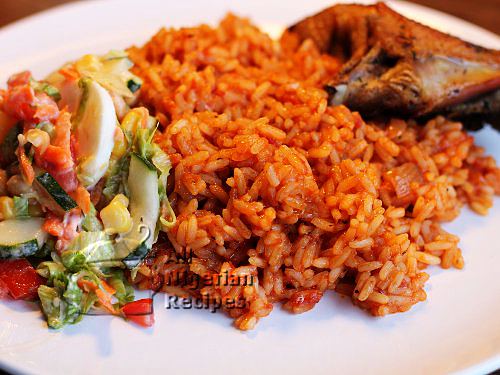 | ||
Alternative names Benachin, riz au gras, theibou dienn Similar Fufu, Moin moin, Suya, Fried plantain, Cooking banana | ||
Jollof rice /ˈdʒɒləf/, also called Benachin (Wolof: "one pot"), is a one-pot rice dish popular in many West African countries. It is a progenitor of the Louisianian dish Jambalaya. World Jollof Rice Day is 22 August.
Contents
- How to make jollof rice
- Geographical range and origin
- Ingredients
- Nigerian and Ghanaian Debate
- Nigerian Jollof
- Ghanaian Jollof
- Nutrition
- Presentation
- References
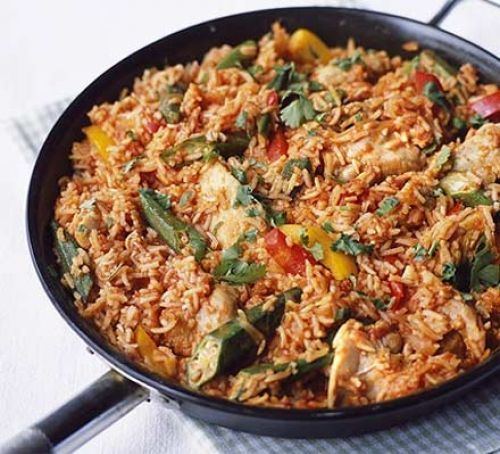
How to make jollof rice
Geographical range and origin
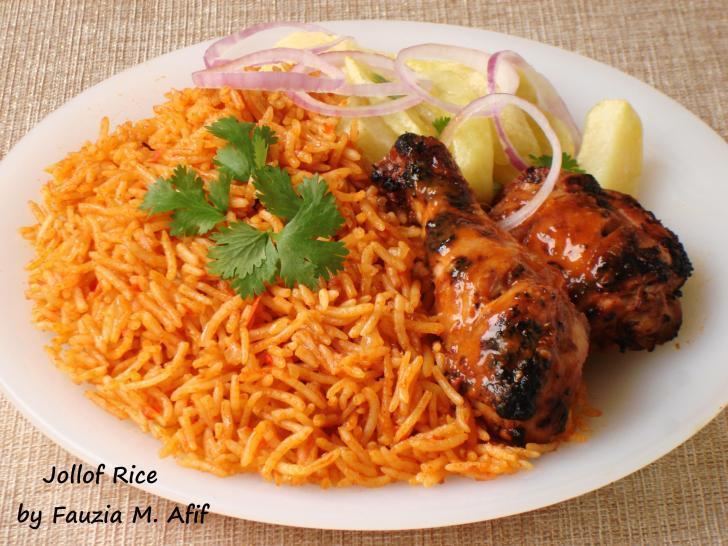
Jollof rice is one of the most common dishes in Western Africa, consumed throughout the region including Senegal, Gambia, Nigeria, Sierra Leone, Liberia, Togo, Cameroon, Mali and Ghana. There are several regional variations in name and ingredients, with non-local versions regarded as "inauthentic". The name Jollof rice derives from the name of the Wolof people, though now called theibou dienn or benachin. In French-speaking areas, it is called riz au gras. Despite the variations, the dish is "mutually intelligible" across the region, and has spread along with the diaspora to become the best known African dish outside the continent.
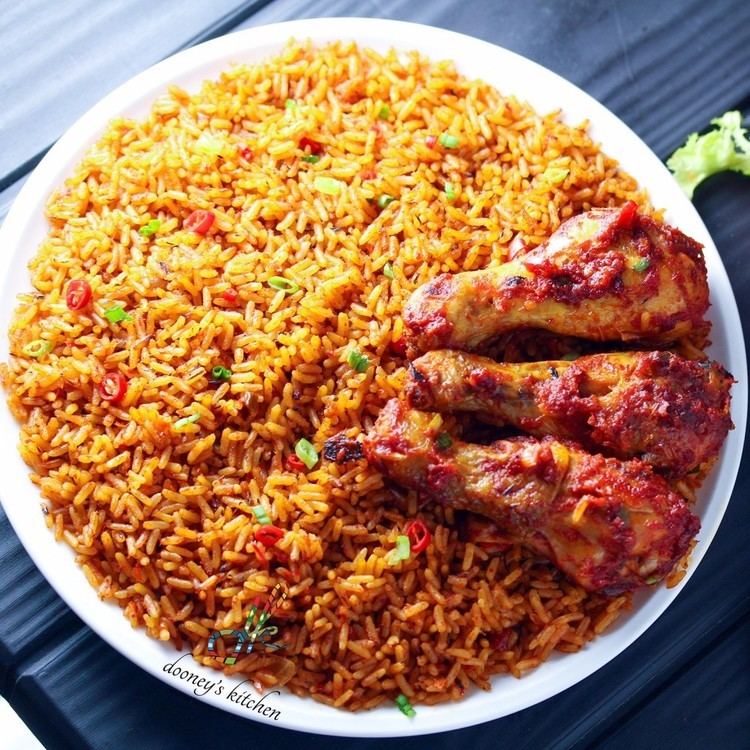
The points of origin of the dish are mostly debated among Ghanaians and Nigerians, since both countries claim to be the origin of jollof rice. Jollof rice is typically seen as a culturally sensitive issue between Nigerians and Ghanaians. Based on its name, the origins of Jollof rice can be traced to the Senegambian region that was ruled by the Jolof Empire. Food and agriculture historian James C. McCann considers this claim plausible given the popularity of rice in the upper Niger valley, but considers it unlikely that the dish could have spread from Senegal to its current range since such a diffusion is not seen in "linguistic, historical or political patterns". Instead he proposes that the dish spread with the Mali empire, especially the Djula tradespeople who dispersed widely to the regional commercial and urban centers, taking with them economic arts of "blacksmithing, small-scale marketing, and rice agronomy" as well as the religion of Islam.
Ingredients
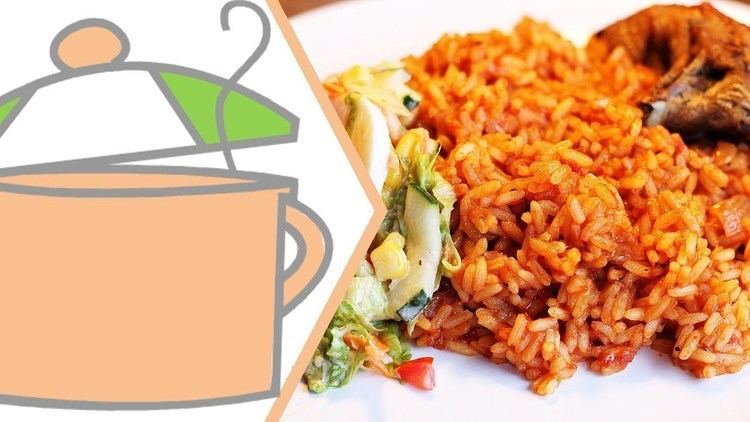
The dish consists of rice, tomatoes and tomato paste, onions, salt, spices (such as nutmeg, ginger, Scotch bonnet (pepper), and cumin) and chili peppers; optional ingredients can be added such as vegetables, meats, or fish. Due to the tomato paste and palm oil, the dish is always red in colour. The recipe differs from region to other.
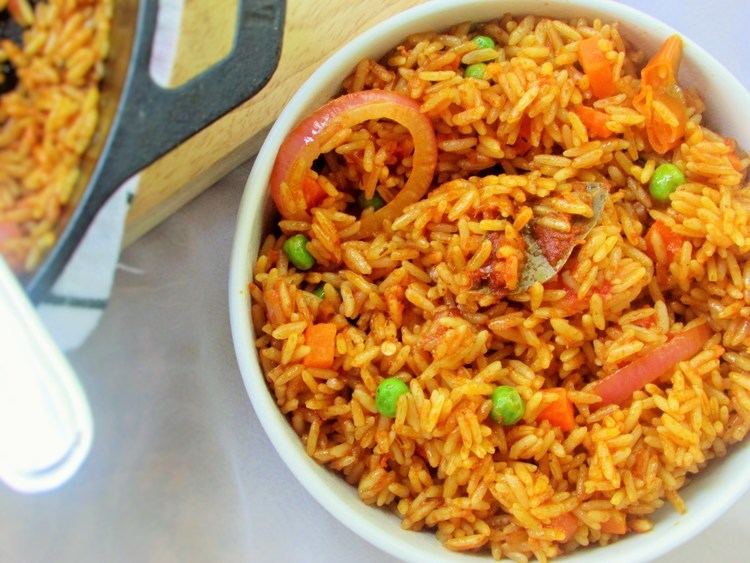
Finely-chopped onions, tomatoes and ground pepper fried in cooking oil, (palm oil or peanut oil) are added to stock and the rice cooked in this mixture, taking on a characteristic orange color from the tomato paste. Jollof rice should not look too red however. It can be served with cooked chicken or fish and vegetables either separately on the plate or stirred in at the end. Optional ingredients can include garlic, peas, thyme, tea-bush leaves, partminger (a herb from the basil family), and curry powder. It is also often served with fried plantain and salad. Jambalaya, a dish traditionally made in the southern United States, is heavily influenced by jollof rice, as well as other West African dishes and spices.
Nigerian and Ghanaian Debate
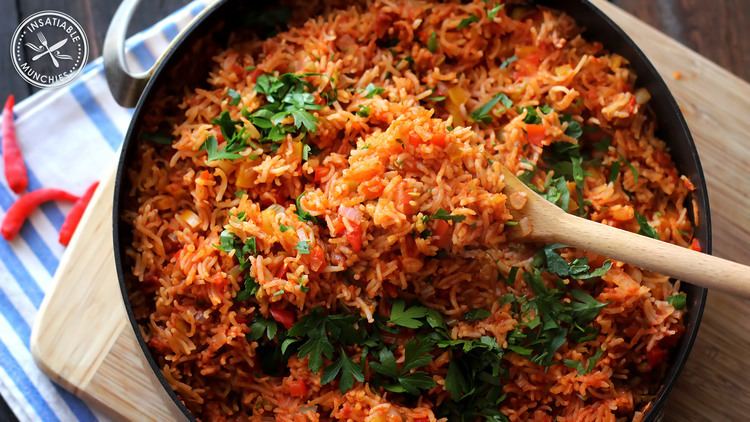
There are multiple regions in Africa who debate over the geographical origins of Jollof rice however, one of the most longstanding and popular debates between two regions, has typically been between Nigerians and Ghanaians. The main argument over this debate is surrounded on which country invented Jollof rice, and whose tastes better. The reason for the debate is due to the huge popularity of Jollof rice, in regards to West African cuisine. Both Nigeria and Ghana have shown consistent competitiveness over the debate as to who can serve the dish the best. The debate has gone so far as to even having organized contest shows, in order for famous critics from all over the world to taste, examine the differences, and give their overall judgments on either forms of the dish. Recently, social media has also become a popular tool for people to share pictures, and opinions over who serves the dish the best.
Nigerian Jollof
Although considerable variation exists, the main ingredients for classic Nigerian jollof rice are the following: long-grain parboiled rice, tomatoes and/or tomato paste, salt, cooking oil, onions, scotch bonnet peppers and red pepper. Common additional accessories include stock, curry, thyme, garlic/ginger and bay leaves. Most of the ingredients are fried in a pot, of which a spicy tomato and pepper blend forms the base. Rice is then added and cooked in water and/or broth. Nigerian jollof rice is generally served with meat/fish and often with such side dishes as fried plantains (“dodo”), moin moin, salad or coleslaw. More economically friendly versions, with stripped down ingredients, are known as “concoction rice,” the preparation of which can involve little rice, tomato, salt and pepper.
Ghanaian Jollof
Ghanaian Jollof rice is made up of vegetable oil, onion, bell pepper, cloves of pressed garlic, chillies, tomato paste, beef or chicken (some times alternated with mixed vegetables), basmati rice and black pepper. The method of cooking Jollof rice begins with first preparing the beef or chicken by seasoning and frying it until it is well cooked. The rest of the ingredients are then fried altogether, starting from onions, tomatoes and spices in that order. After all the ingredients have been fried, rice is then added and cooked until the meal is prepared. Ghanaian Jollof is typically served with side dishes of beef/chicken/well seasoned and fried fish and/or mixed vegetables.
Nutrition
The main ingredients of Jollof rice are rice and tomatoes; neither has any saturated fat or cholesterol. Jollof rice contains carbohydrates, primarily from the rice. Since Jollof rice is served with chicken, beef, eggs and/or turkey, the dish is fairly high in protein. Fish is also another alternative to these meats, and can provide the dish with omega-3 fatty acids, as well as some protein. Vegetarians often choose to eat Jollof rice with salad or cole slaw instead of meat, and gain vitamins and minerals. Tomatoes also play a primary role in rice, and provide a good amount of vitamins and minerals.
Presentation
On the event of special occasions such as birthdays, weddings or baby showers, the dish can be presented and served made into shapes, overall a more formal presentation of the dish. Fried plantain is also placed on top, or beside the Jollof rice, and then various meats are added around the rest of the dish.
